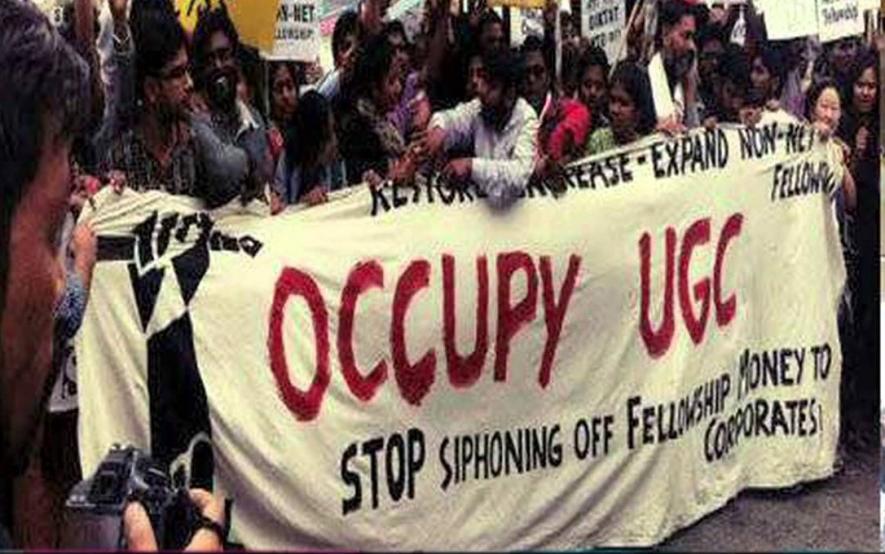Modi Government’s Economic Attacks on Students
Ab Ki Baar, Fund Cuts Ki Sarkaar!
Education sector has seen remarkable reduction of budgetary allocations during the Modi regime. This downward spiral started from the first budget itself, which the Modi government presented. For the Dept. of School Education & Literacy, Modi Sarkar spent Rs.45722 crore in 2014-15, down by Rs.1134 crore over the previous year (UPA’s last year). Then in 2015-16 Rs.42187 is estimated to have been spent (revised estimates), further down by Rs.3535 crore. Finally in 2016-17 budgeted allocation, the govt. has allocated Rs.43554 crore, up by about Rs.1367 crore over the previous year. So, Modi sarkar’s latest budget has cut funding for schools and literacy by Rs.3302 cr or 7% since UPA’s last year. Considering that school going children’s population is increasing by about 2% per year, any cuts will translate into severe damage to the most deprived and remotely situated people. It will also push people into the arms of private schools with exorbitant fees and uncertain benefits.

Image Courtesy: youtube.in
For the flagship Sarva Shiksha Abhiyan, Modi sarkar’s latest budget of 2016-17 allocated Rs.22500 crore, which is Rs.1597 crore less than its first budget allocation in 2014-15 of Rs.24097 cr. There has been an increase in budgetary support for secondary schools (Rs.302 crore) and for higher education (Rs.883 crore).
Spending for teachers’ training and Sakshar Bharat has been cut from Rs.1158 crore to Rs.879 crore, a drastic cut of Rs.279 crore or nearly 25% in the past two years.
The crucial Mid-Day Meal scheme has received a cut of Rs.823 crore or about 8% in these two years. Meanwhile allocation for IITs and IIMs has increased by Rs.1441 crore or 33% under the Modi Sarkar.
If you look at the education spending by the central govt. as a proportion of either total govt. expenditure or GDP, the real picture emerges in stark form. The trend started by the UPA in its last years – of cutting down spending on education and other crucial social sectors – is being continued with gusto by the Modi sarkar. Here is how it looks: spending on education as a share of GDP was 0.66% in 2012-13, 0.63% in 2013-14 (both UPA years), and then – 0.55% in 2014-15, 0.50% in 2015-16, and 0.48% in the Budget estimates for 2016-17. Remember: it is well accepted that at least 6% of the GDP should be spent on education in order to provide good quality education for all. Two years of Modi Sarkar shows a steady retreat from this goal.
As a share of total govt. expenditure, central govt. spend on education declined from 4.7% in 2012-13 to 4.6% in 2013-14 (UPA’s last two years) and then – 4.1% in 2014-15, 3.8% in 2015-16 down to 3.7% in budget estimates for 2016-17.
The Right to Education (RTE), which was introduced during the UPA 1 has proved to be ineffective given the lack of financial accountability from successive central governments. Central and state governments are required to share the RTE budget on a 65:35 proportion (90:10 in the North East) but most states have been unable to provide their share. The continued reduction in the plan outlay for the school education will mean that the stated aim of ‘achieving free and compulsory education’ would become even more elusive. Today only 63% of schools have student- teacher ratio as per the RTE norms. If we take other indicators such as infrastructure or availability of toilets for girl students then the numbers will dip further.
The reduced allocations in various sectors are contrary to the 12th Plan objectives regarding expansion, growth, access, or quality of Higher Education. In fact, the government has scrapped the planning process altogether. The 12th Plan approach paper on Higher education had proposed that 18 per cent of all Government education spending or 1.12 per cent of GDP should be on Higher Education, and Parliament's Standing Committee on HRD recommended raising it to 25 per cent and 1.5 per cent respectively.
Siphoning Public funds to Private Players
The finance minister in his speech has talked about an ‘enabling regulatory architecture’ for 10 public and 10 private educational institutions to be made ‘world-class’. This will enhance the dual education model that creates a minuscule number of so-called centres of excellence while the vast majority of institutions are forced to remain cash-starved. Another disturbing feature is the inclusion of 10 private institutions in this framework, which is a continuation of the regressive outlook of RUSA and other such academic reforms which have been seeking to divert public funds to private players (while there is no social control over the fees, infrastructure, teaching etc. in these institutions).
A Higher Education Financing Agency (HEFA) is being set up with the initial base capital of Rs. 1000 crore. Finance Minister in his speech has said that ‘These funds will be used to finance improvement in infrastructure in our top institutions and will be serviced through internal accruals.’ This again means: 1) Diversion of funds to select few institutes 2) Linking of funds to the financial performance of the institutes (since internal accruals refer to the accumulation of retained earnings and depreciation charges).
All this is being done with almost criminal resonance with the moves towards again bringing the Foreign Educational Institutions bill, which were stalled when the Congress government tried to bring it in 2009. It is interesting to note that while the BJP was against FEI then, PM Modi personally gave directions to the NITI Ayog to make policy formulations which could ease the entry of foreign educational providers in the country.
Further, for the Rashtriya Uchhtar Shiksha Abhiyaan (RUSA), a provision of Rs 1300 crore has been made in the Budget, up from Rs 1155 crore in the current financial year. The centrally sponsored scheme launched in 2013 aims at providing strategic funding to eligible state higher educational institutions. RUSA, which was introduced by the Congress-led UPA-II government and has been carried further by the BJP-led NDA government, replaces the pre-existing multiple funding mechanisms with one centralised mechanism. The funding then is linked to a set of conditions failing which the institutions/states will not be eligible to receive funds. These conditions include implementation of Choice Based Credit System (CBCS), semesterization and compulsory accreditation among others. The same document makes it clear that the funding under RUSA will be norm based as well as performance based. This means that the state governments or universities will not have any room to modify the system according to their specific conditions and all powers to determine their education are snatched away from them. Funding will be linked to the performance of the institution, based on set criteria which would include student-teacher ratio, infrastructure, examination results etc. This would effectively spiral into increasing the already existing inequalities. For example, let us consider St. Stephen’s College in Delhi and Rajendra Mishra College in Saharsa, Bihar. If funding is linked to accreditation, then St. Stephen’s College will continue getting more funds every year due to better ‘indicators’. Rajendra Mishra College, which needs more funds to enhance its infrastructure, will actually keep on getting less and lesser funds every year. Hence, this performance-based approach to funding will actually widen the existing gulf. RUSA has provision to divert funds to even such institutions, which do not fall under section 12B and 2(f) of the UGC Act. This translates into the provision of diverting the public money (tax collected from the working class and other toiling sections) to fund the private institutions, which are anyways free to charge exorbitant fees.
Education of the marginalized put at stake
These budget cuts have had direct impact on the students in general and the students from the marginalized sections in particular. In the last two years, we have seen steep fee hikes in numerous government institutions. The fees for the B.Tech courses in the IITs have been increased from Rs.90,000 per annum to Rs.2 lakh per annum. The application fees for the CSIR-NET examinations saw a massive increase of 250%.
“I have to get seven months of my fellowship, one lakh and seventy five thousand rupees. Please see to it that my family is paid that”, wrote Rohith Vemula in his suicide note. This is only a reflection of how the delays in government-sponsored scholarships drive the students from Schedule Caste and Schedule Tribe (SC/ST) communities into desperation. Fellowship schemes like Rajiv Gandhi National fellowship, Maulana Azad National fellowship, CSIR-JRF and UGC-JRF are the only means by which hundreds of students from socio-economically deprived backgrounds are able to continue their higher studies. Many such students have to send a significant portion of their fellowships back home also. But, over the last two years, the budget cut has translated into delays up to eight-nine months in the disbursal of the fellowships. In the 2014-15 revised budget estimates, the government reduced funds for higher education by Rs. 3,900 crore. Prior to this, the universities used to release the stipends from their own coffers, knowing that the University Grants Commission (UGC) would reimburse them on time. However, this is no longer the case.
The UGC decision to stop the non-NET fellowships also emerged out of the fund cuts. It was a different matter though that the government was forced to backtrack following nationwide protests. There are apprehensions though that some form of ‘targeting’ will be introduced in this scheme which used to cover nearly 35,000 research scholars. Students on the other hand have been demanding the scheme to be extended to all state universities, fellowship amounts to be doubled and be linked with the inflation index.
Skill Development in air
Finance Minister’s speech (2016) talks about ‘Entrepreneurship Education and Training’ through Massive Open Online Courses (MOOCs). Global experience shows that over-reliance on MOOCs as a tool of vocationalization ends up increasing the duality within the education system and in effect serves as a means of providing cheap labour for the big business.
There is lot of talk about skill development in the finance minister’s budget, but one is forced to wonder how this rhetoric will be translated into action when the allocations for UGC/IITs/IIMs/NITs have been cut by more than 50%.
Student movement in this period has played an important role in resisting the authoritarian assaults on the universities and on democracy. It cannot afford to remain oblivious of the continuing ‘economic attacks’ either.
Disclaimer: The views expressed here are the author's personal views, and do not necessarily represent the views of Newsclick
Get the latest reports & analysis with people's perspective on Protests, movements & deep analytical videos, discussions of the current affairs in your Telegram app. Subscribe to NewsClick's Telegram channel & get Real-Time updates on stories, as they get published on our website.























